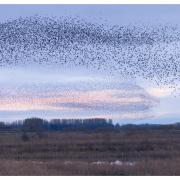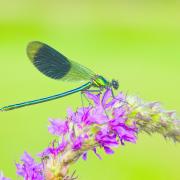With the boxing prowess of Amir Khan and the athletic ability of Usain Bolt, the brown hare is one of Yorkshire’s most intriguing wild creatures. But when it comes to March, are they really going mad? Tom Marshall investigates

With Mother Nature having thrown what seems like everything she has at her disposal at Yorkshire in recent months, you could forgive the local wildlife for losing the plot a little. Daffodils blooming at Christmas, summer swallows swooping along the coast, and swans swimming along central York streets. However, when it comes to a cerebral leave of absence, there’s one animal that seems to have this month all to itself, the so-called ‘mad’ March hare.
There’s certainly no shortage of wildlife having hopped, flown or stealthily stalked its way into British culture over the years. We can be up with the lark, as sly as a fox, or indeed have the work ethic of a bee. But you really can only be mad as a March hare. Such a reputation also can’t be helped by being at the head of perhaps the daftest dinner table of all in Lewis Carroll’s Alice in Wonderland.
Unfortunately, along with another furry literary figure, the smaller river-dwelling water vole – he of Ratty and Wind in the Willows fame – the brown hare now finds itself in the precarious position as one of the most rapidly declining mammals in the UK. A combination of changes to our fields and crops and increased mechanisation has all taken its toll on the hare. Thankfully though, the rolling hills of God’s Own Country are still a great place to spot hares this spring.
Sometimes hard to distinguish at a distance, the hare’s larger and black-tipped ears initially set it apart from the smaller rabbits. Rather unhelpfully, the stealthy tactics of the hare among the crop fields and tractor tram tracks often finds them holding their ears close to their head to remain somewhat less conspicuous.

The subterranean lifestyle of the rabbit isn’t shared by the hare either, who in fact lives its whole life above ground, in something of a nomadic fashion. For the hare, wherever it lays its ears, that’s its home.
During March though, this shy and secretive mammal takes on a new personality, and the same fields that have helped hide them away become prime sporting arenas.
The sight of ‘boxing’ hares remains a sure sign of the changing seasons, and if the autumn rutting of deer is a rough and tumble back-street brawl, then the hare offers viewers a highly-skilled prize fight where every move is considered with the nip and tuck of Ali or Cooper. Not so much mad as once thought, but simply rolling with the punches.
Most surprising of all however, is that these displays of organised violence are not between chauvinistic groups of male would-be suitors pressing their advantage for a potential mate, but in fact between the males and females themselves, sizing each other up as the perfect couple. The hares who spar together, stay together, so it seems.

With the action in the ring all but concluded, the next hottest tickets in the house are for the 100 metre dash, an almost superhuman burst of power that can propel the best in world
through 10 metres in less than a second. Although with a slight advantage of an additional pair of legs, our own brown hare would leave most sprinters standing with an average speed of 45mph – more than enough to beat the current world’s best who would barely set off a speed camera at a positively leisurely 27mph in top gear.
Such athleticism (in contrast to the haphazard scampering of their smaller cousin), comes from an enlarged and muscular pair of hind legs coupled with a highly flexible spine and extra-stretchy tendons. Couple this with an energy-storing criss-cross action with their front legs when in full flow, and the hare can cover several feet with each leap.
A fight and a sprint may not seem everyone’s idea of the most romantic of pre-mating rituals, but it certainly works for Yorkshire’s brown hares. Mad or not? I’ll leave that up to you.



























